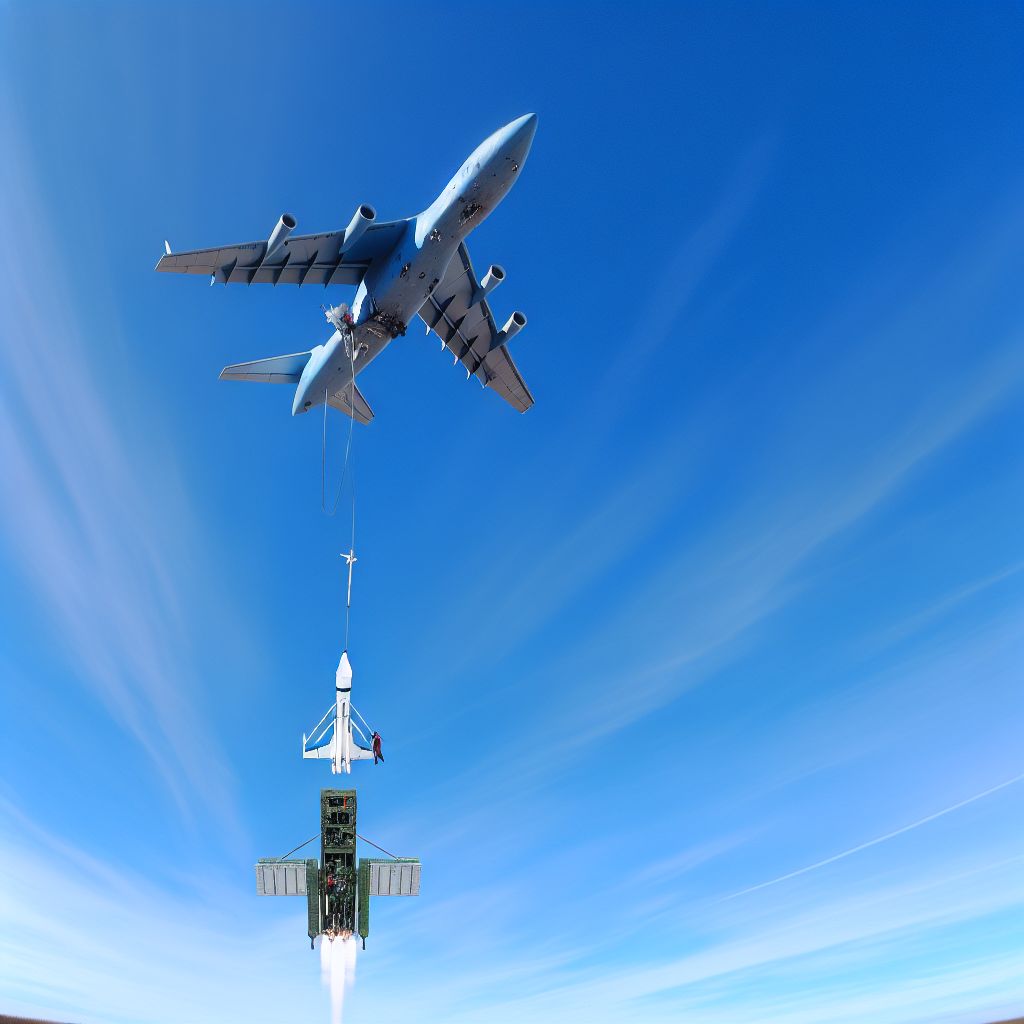In the Space industry context, "Air-launch" refers to a method of launching Spacecraft where the launch vehicle, carrying the satellite or spacecraft, is initially carried aloft by a larger carrier Aircraft. Once at a predetermined altitude, the launch vehicle is released from the carrier aircraft and ignites its engines to propel itself into Space. This method contrasts with traditional Ground-based launches, where the rocket is launched directly from the Earth's surface.
General Description

Air-launch offers several advantages over traditional launch methods. It allows for more flexibility in launch locations and timings, as the carrier aircraft can avoid adverse weather conditions and fly to optimal launch points. This method can also lead to cost savings and increased efficiency, as it requires less fuel to reach Orbit from the already elevated altitude and can utilize existing aircraft Technology and Infrastructure. Additionally, air-launch systems are considered to have a lower environmental impact, given the reduced need for large launch facilities and ground-based infrastructure.
Application Areas
- Satellite Deployment: Small satellites, particularly those destined for low Earth orbit (LEO), are ideal candidates for air-launch due to the method's cost-effectiveness and flexibility.
- Research Missions: Air-launch is used for scientific research missions that require specific launch conditions or trajectories not easily achievable from ground-based sites.
- Space Tourism: Some air-launch systems are being developed for suborbital space tourism, offering a unique method for space travel.
Risks and Challenges
Despite its advantages, air-launch faces challenges, including the limitations on the size and Weight of the Payload due to the carrying capacity of the carrier aircraft. There are also technical and safety challenges related to the release and Ignition of the launch vehicle at high altitudes. Ensuring the reliability and safety of air-launch systems requires extensive testing and certification processes.
Summary
Air-launch represents a flexible, cost-effective, and innovative method of accessing space, offering significant benefits for satellite deployment, research missions, and potential applications in space tourism. Despite facing specific challenges, the Development of air-launch technology continues to advance, promising to play a significant role in the future of space exploration and the commercial space industry.
--
Related Articles to the term 'Air-launch' | |
| 'Launch Vehicle' | ■■■■■■■■ |
| Launch Vehicle in the space industry refers to a rocket or spacecraft specifically designed to propel . . . Read More | |
| 'Fuel absorption' | ■■■■■■ |
| Fuel Absorption in the space industry context typically refers to the process or technology used to manage . . . Read More | |
| 'Active Aerodynamics' | ■■■■■■ |
| Active Aerodynamics in the space industry context refers to the use of systems that dynamically adjust . . . Read More | |
| 'Launch Vehicle Engineering' | ■■■■■■ |
| Launch Vehicle Engineering refers to the Design, development, and Optimization of rockets or vehicles . . . Read More | |
| 'Geostationary Satellite' | ■■■■■■ |
| Geostationary Satellite in the space industry context refers to a type of satellite that is specifically . . . Read More | |
| 'Riveting' | ■■■■■ |
| Riveting in the space industry refers to the mechanical process of joining materials, typically sheets . . . Read More | |
| 'Rocket Propulsion' | ■■■■■ |
| Rocket Propulsion in the space industry context refers to the method by which rockets and spacecraft . . . Read More | |
| 'Satellite deployment' | ■■■■■ |
| Satellite deployment in the space industry context refers to the process of placing a satellite into . . . Read More | |
| 'Testing' | ■■■■■ |
| Testing in the space industry context refers to the comprehensive and systematic processes conducted . . . Read More | |
| 'First-stage' | ■■■■■ |
| First-stage in the space industry context refers to the initial part of a rocket's launch system, which . . . Read More | |
